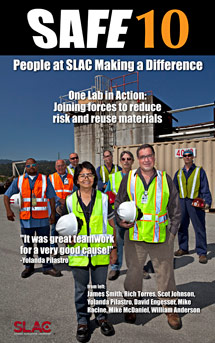
Handy Links
SLAC News Center
SLAC Today
- Subscribe
- Archives: Feb 2006-May 20, 2011
- Archives: May 23, 2011 and later
- Submit Feedback or Story Ideas
- About SLAC Today
SLAC News
Lab News
- Interactions
- Lightsources.org
- ILC NewsLine
- Int'l Science Grid This Week
- Fermilab Today
- Berkeley Lab News
- @brookhaven TODAY
- DOE Pulse
- CERN Courier
- DESY inForm
- US / LHC
SLAC Links
- Emergency
- Safety
- Policy Repository
- Site Entry Form

- Site Maps
- M & O Review
- Computing Status & Calendar
- SLAC Colloquium
- SLACspeak
- SLACspace
- SLAC Logo
- Café Menu
- Flea Market
- Web E-mail
- Marguerite Shuttle
- Discount Commuter Passes
-
Award Reporting Form
- SPIRES
- SciDoc
- Activity Groups
- Library
Stanford
Around the Bay
SAFE2010: SLACers Join Forces to Reduce Risks and Re-use Materials
The age-old maxim that there is strength in numbers rings true when it comes to safety at SLAC National Accelerator Laboratory. Several departments, including Waste Management, Facilities and Environmental Safety and Health, worked together to remove two modules containing tubes of ethane gas from a site near Interaction Region 6, where they had sat untouched for several years. In addition to creating a safer environment for SLAC employees, the groups found a way to reuse the material that resulted in a cost savings for the lab.
A now-retired SLAC engineer ordered the ethane for use in the Stanford Large Detector experiment on the former SLAC Linear Collider. When the research came to a close in 2001, the spare ethane tubes were left at the site to await a new home. The two trailersóeach containing 38 tubes of the highly flammable ethane gasówere moved from site 750 to site B666 to make way for the construction of the Linac Coherent Light Source in the fall of 2006.
The question of finding them a permanent home landed in the lap of Waste Management section leader Yolanda Pilastro in July 2009.
"I knew this project would be a challenge," she said.
Pilastro immediately began searching for ways to reuse the gas, either at SLAC, another Department of Energy site or a commercial vendor. After extensive networking, she located Airgas, a Pennsylvania-based distributor that was willing to take the ethane tubes and transport them to their Houston, Texas facility to be reused.
The plan was finalized in December 2009, after significant planning and preparing shipping documents in compliance with Department of Transportation and Environmental Protection Agency regulations. The trailers were removed from SLAC in May 2010.
In all, the arrangement saved SLAC upwards of $100,000 in transportation and disposal costs.
The removal process itself involved some risks, given the highly flammable nature of ethane. Particle Physics and Astrophysics mechanical engineer Mike Racine, who took custody of the tubes in 2008, was responsible for disconnecting the grounding on the trailers and ensuring that they could be lifted safely off the ground. Rich Torres and his team of riggers then took over, attaching lifting cables to each corner of the tube modules. They then carefully guided the modules as a crane hoisted them into the air and positioned them on the truck beds that would haul them halfway across the country.
"I knew things were good when the trucks left SLAC, but I wasn't completely relieved until they arrived in Texas," Pilastro said.
The trailers arrived safely, marking a successful end to a carefully planned and incident-free operation. "We don't often think about the risk of the 'leftovers' from the pursuit of fantastic science," said ES&H Director Craig Ferguson. "This is a great example of removing a legacy hazard from our site, avoiding significant cost of transportation and disposal, and getting material into the hands of people who will reuse it. It was a great accomplishment by Waste Management, Facilities, Procurement, and all involved."
óLauren Rugani
SLAC Today, August 9, 2010
